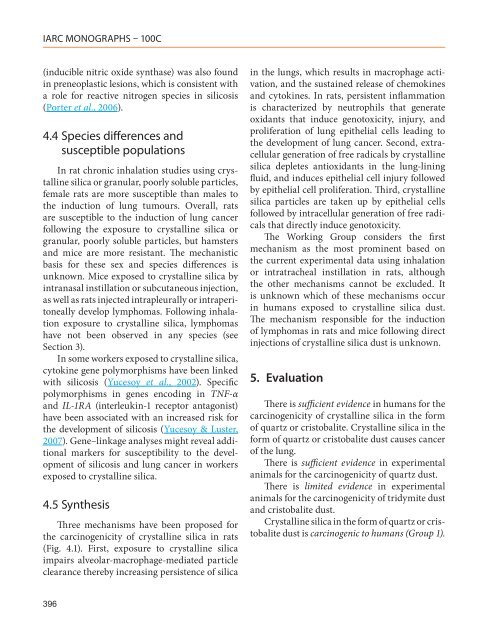silica dust, crystalline, in the form of quartz or cristobalite - IARC ...
silica dust, crystalline, in the form of quartz or cristobalite - IARC ...
silica dust, crystalline, in the form of quartz or cristobalite - IARC ...
You also want an ePaper? Increase the reach of your titles
YUMPU automatically turns print PDFs into web optimized ePapers that Google loves.
<strong>IARC</strong> MONOGRAPHS – 100C<br />
(<strong>in</strong>ducible nitric oxide synthase) was also found<br />
<strong>in</strong> preneoplastic lesions, which is consistent with<br />
a role f<strong>or</strong> reactive nitrogen species <strong>in</strong> silicosis<br />
(P<strong>or</strong>ter et al., 2006).<br />
4.4 Species differences and<br />
susceptible populations<br />
In rat chronic <strong>in</strong>halation studies us<strong>in</strong>g <strong>crystall<strong>in</strong>e</strong><br />
<strong>silica</strong> <strong>or</strong> granular, po<strong>or</strong>ly soluble particles,<br />
female rats are m<strong>or</strong>e susceptible than males to<br />
<strong>the</strong> <strong>in</strong>duction <strong>of</strong> lung tumours. Overall, rats<br />
are susceptible to <strong>the</strong> <strong>in</strong>duction <strong>of</strong> lung cancer<br />
follow<strong>in</strong>g <strong>the</strong> exposure to <strong>crystall<strong>in</strong>e</strong> <strong>silica</strong> <strong>or</strong><br />
granular, po<strong>or</strong>ly soluble particles, but hamsters<br />
and mice are m<strong>or</strong>e resistant. The mechanistic<br />
basis f<strong>or</strong> <strong>the</strong>se sex and species differences is<br />
unknown. Mice exposed to <strong>crystall<strong>in</strong>e</strong> <strong>silica</strong> by<br />
<strong>in</strong>tranasal <strong>in</strong>stillation <strong>or</strong> subcutaneous <strong>in</strong>jection,<br />
as well as rats <strong>in</strong>jected <strong>in</strong>trapleurally <strong>or</strong> <strong>in</strong>traperitoneally<br />
develop lymphomas. Follow<strong>in</strong>g <strong>in</strong>halation<br />
exposure to <strong>crystall<strong>in</strong>e</strong> <strong>silica</strong>, lymphomas<br />
have not been observed <strong>in</strong> any species (see<br />
Section 3).<br />
In some w<strong>or</strong>kers exposed to <strong>crystall<strong>in</strong>e</strong> <strong>silica</strong>,<br />
cytok<strong>in</strong>e gene polym<strong>or</strong>phisms have been l<strong>in</strong>ked<br />
with silicosis (Yucesoy et al., 2002). Specific<br />
polym<strong>or</strong>phisms <strong>in</strong> genes encod<strong>in</strong>g <strong>in</strong> TNF-α<br />
and IL-1RA (<strong>in</strong>terleuk<strong>in</strong>-1 recept<strong>or</strong> antagonist)<br />
have been associated with an <strong>in</strong>creased risk f<strong>or</strong><br />
<strong>the</strong> development <strong>of</strong> silicosis (Yucesoy & Luster,<br />
2007). Gene–l<strong>in</strong>kage analyses might reveal additional<br />
markers f<strong>or</strong> susceptibility to <strong>the</strong> development<br />
<strong>of</strong> silicosis and lung cancer <strong>in</strong> w<strong>or</strong>kers<br />
exposed to <strong>crystall<strong>in</strong>e</strong> <strong>silica</strong>.<br />
4.5 Syn<strong>the</strong>sis<br />
Three mechanisms have been proposed f<strong>or</strong><br />
<strong>the</strong> carc<strong>in</strong>ogenicity <strong>of</strong> <strong>crystall<strong>in</strong>e</strong> <strong>silica</strong> <strong>in</strong> rats<br />
(Fig. 4.1). First, exposure to <strong>crystall<strong>in</strong>e</strong> <strong>silica</strong><br />
impairs alveolar-macrophage-mediated particle<br />
clearance <strong>the</strong>reby <strong>in</strong>creas<strong>in</strong>g persistence <strong>of</strong> <strong>silica</strong><br />
<strong>in</strong> <strong>the</strong> lungs, which results <strong>in</strong> macrophage activation,<br />
and <strong>the</strong> susta<strong>in</strong>ed release <strong>of</strong> chemok<strong>in</strong>es<br />
and cytok<strong>in</strong>es. In rats, persistent <strong>in</strong>flammation<br />
is characterized by neutrophils that generate<br />
oxidants that <strong>in</strong>duce genotoxicity, <strong>in</strong>jury, and<br />
proliferation <strong>of</strong> lung epi<strong>the</strong>lial cells lead<strong>in</strong>g to<br />
<strong>the</strong> development <strong>of</strong> lung cancer. Second, extracellular<br />
generation <strong>of</strong> free radicals by <strong>crystall<strong>in</strong>e</strong><br />
<strong>silica</strong> depletes antioxidants <strong>in</strong> <strong>the</strong> lung-l<strong>in</strong><strong>in</strong>g<br />
fluid, and <strong>in</strong>duces epi<strong>the</strong>lial cell <strong>in</strong>jury followed<br />
by epi<strong>the</strong>lial cell proliferation. Third, <strong>crystall<strong>in</strong>e</strong><br />
<strong>silica</strong> particles are taken up by epi<strong>the</strong>lial cells<br />
followed by <strong>in</strong>tracellular generation <strong>of</strong> free radicals<br />
that directly <strong>in</strong>duce genotoxicity.<br />
The W<strong>or</strong>k<strong>in</strong>g Group considers <strong>the</strong> first<br />
mechanism as <strong>the</strong> most prom<strong>in</strong>ent based on<br />
<strong>the</strong> current experimental data us<strong>in</strong>g <strong>in</strong>halation<br />
<strong>or</strong> <strong>in</strong>tratracheal <strong>in</strong>stillation <strong>in</strong> rats, although<br />
<strong>the</strong> o<strong>the</strong>r mechanisms cannot be excluded. It<br />
is unknown which <strong>of</strong> <strong>the</strong>se mechanisms occur<br />
<strong>in</strong> humans exposed to <strong>crystall<strong>in</strong>e</strong> <strong>silica</strong> <strong>dust</strong>.<br />
The mechanism responsible f<strong>or</strong> <strong>the</strong> <strong>in</strong>duction<br />
<strong>of</strong> lymphomas <strong>in</strong> rats and mice follow<strong>in</strong>g direct<br />
<strong>in</strong>jections <strong>of</strong> <strong>crystall<strong>in</strong>e</strong> <strong>silica</strong> <strong>dust</strong> is unknown.<br />
5. Evaluation<br />
There is sufficient evidence <strong>in</strong> humans f<strong>or</strong> <strong>the</strong><br />
carc<strong>in</strong>ogenicity <strong>of</strong> <strong>crystall<strong>in</strong>e</strong> <strong>silica</strong> <strong>in</strong> <strong>the</strong> <strong>f<strong>or</strong>m</strong><br />
<strong>of</strong> <strong>quartz</strong> <strong>or</strong> <strong>cristobalite</strong>. Crystall<strong>in</strong>e <strong>silica</strong> <strong>in</strong> <strong>the</strong><br />
<strong>f<strong>or</strong>m</strong> <strong>of</strong> <strong>quartz</strong> <strong>or</strong> <strong>cristobalite</strong> <strong>dust</strong> causes cancer<br />
<strong>of</strong> <strong>the</strong> lung.<br />
There is sufficient evidence <strong>in</strong> experimental<br />
animals f<strong>or</strong> <strong>the</strong> carc<strong>in</strong>ogenicity <strong>of</strong> <strong>quartz</strong> <strong>dust</strong>.<br />
There is limited evidence <strong>in</strong> experimental<br />
animals f<strong>or</strong> <strong>the</strong> carc<strong>in</strong>ogenicity <strong>of</strong> tridymite <strong>dust</strong><br />
and <strong>cristobalite</strong> <strong>dust</strong>.<br />
Crystall<strong>in</strong>e <strong>silica</strong> <strong>in</strong> <strong>the</strong> <strong>f<strong>or</strong>m</strong> <strong>of</strong> <strong>quartz</strong> <strong>or</strong> <strong>cristobalite</strong><br />
<strong>dust</strong> is carc<strong>in</strong>ogenic to humans (Group 1).<br />
396
















